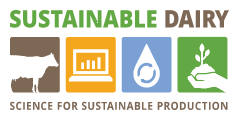Proceedings Home | W2W Home 
Purpose
The goal of the Sustainable Dairy “Virtual Farm” website is to disseminate research-based information to diverse audiences from one platform. This is done with layers of information starting with the m ost basic then drilling down to peer-reviewed publications, data from life-cycle assessment studies and models related to the topics. The Virtual Farm focuses on decision makers and stakeholders including consumers, producers, policymakers, scientists and students who are interested in milk production on modern dairy farms. The top entry level of the site navigates through agricultural topics of interest to the general public. Producers can navigate to a middle level to learn about practices and how they might help them continue to produce milk for consumers responsibly in a changing climate while maintaining profitability. Featured beneficial (best) management practices (BMPs) reflect options related to dairy sustainability, climate change, greenhouse gas emissions, and milk production. Researchers can navigate directly to deeper levels to publications, tools, models, and scientific data. The website is designed to encourage users to dig deeper and discover more detailed information as their interest develops related to sustainable dairies and the environment.
ost basic then drilling down to peer-reviewed publications, data from life-cycle assessment studies and models related to the topics. The Virtual Farm focuses on decision makers and stakeholders including consumers, producers, policymakers, scientists and students who are interested in milk production on modern dairy farms. The top entry level of the site navigates through agricultural topics of interest to the general public. Producers can navigate to a middle level to learn about practices and how they might help them continue to produce milk for consumers responsibly in a changing climate while maintaining profitability. Featured beneficial (best) management practices (BMPs) reflect options related to dairy sustainability, climate change, greenhouse gas emissions, and milk production. Researchers can navigate directly to deeper levels to publications, tools, models, and scientific data. The website is designed to encourage users to dig deeper and discover more detailed information as their interest develops related to sustainable dairies and the environment.
What did we do?
As part of a USDA Dairy Coordinated Agricultural Project addressing climate change issues in the Great Lakes region, this online platform was developed to house various products of the transdisciplinary project in an accessible learning site. The Virtual Farm provides information about issues surrounding milk production, sustainability, and farm-related greenhouse gases. The web interface features a user-friendly, visually-appealing interactive “virtual farm” that explains these issues starting at a less-technical level, while also leading to much deeper research into each area. The idea behind this was to engage a general audience, then encourage them to dig deeper into the website for more technical information via Extension offerings.
The main landing page shows two sizes of dairy farms: 150 and 1,500-cows. The primary concept was to replace an all-day tour of multiple real dairy farms by combining their features into one ‘virtual farm’. For example, the virtual farm can describe and demonstrate the impact of various manure processing technologies. Users can explore the layout image, hover over labeled features for a brief description, and click to learn more about five main categories: crops and soils, manure management, milk production, herd management, and feed management. Each category page contains a narrative overview with illustrations and links to more detailed information.
What have we learned?
The primary benefit is that participants can learn about different practices, at their level of interest, all in one place. The virtual farm incorporates a broad theme of sustainability targeted at farming operations in the northeastern Great Lakes region of the USA.
The project has included regional differences in dairy farming practices and some important reasons for this such as environmental concerns (focus on N and/or P management in different watersheds) and long-term climate projections. Dairy industry supporters find value in having a one-stop repository of information on overall sustainability topics rather than having to visit various organizations’ sites.
Future Plans
We plan to continue to develop the website by adding relevant information, keeping information up to date, developing the platform for related topic areas and adding curriculums for school students.
Corresponding author, title, and affiliation
Daniel Hofstetter, Extension-Research Assistant, Penn State University (PSU)
Corresponding author email
Other authors
Eileen Fabian-Wheeler, Professor, PSU; Rebecca Larson, Assistant Professor, University of Wisconsin (UW); Horacio Aguirre-Villegas, Assistant Scientist, UW; Carolyn Betz, Project Manager, UW; Matt Ruark, Associate Professor, UW
Additional information
Visit the following link for more information about the Sustainable Dairy CAP Project:
http://www.sustainabledairy.org
Acknowledgements
This material is based upon work that is supported by the National Institute of Food and Agriculture, U.S. Department of Agriculture, under award number 2013-68002-20525. Any opinions, findings, conclusions or recommendations expressed in this publication are those of the author(s) and do not necessarily reflect the view of the U.S. Department of Agriculture.
The authors are solely responsible for the content of these proceedings. The technical information does not necessarily reflect the official position of the sponsoring agencies or institutions represented by planning committee members, and inclusion and distribution herein does not constitute an endorsement of views expressed by the same. Printed materials included herein are not refereed publications. Citations should appear as follows. EXAMPLE: Authors. 2017. Title of presentation. Waste to Worth: Spreading Science and Solutions. Cary, NC. April 18-21, 2017. URL of this page. Accessed on: today’s date.

